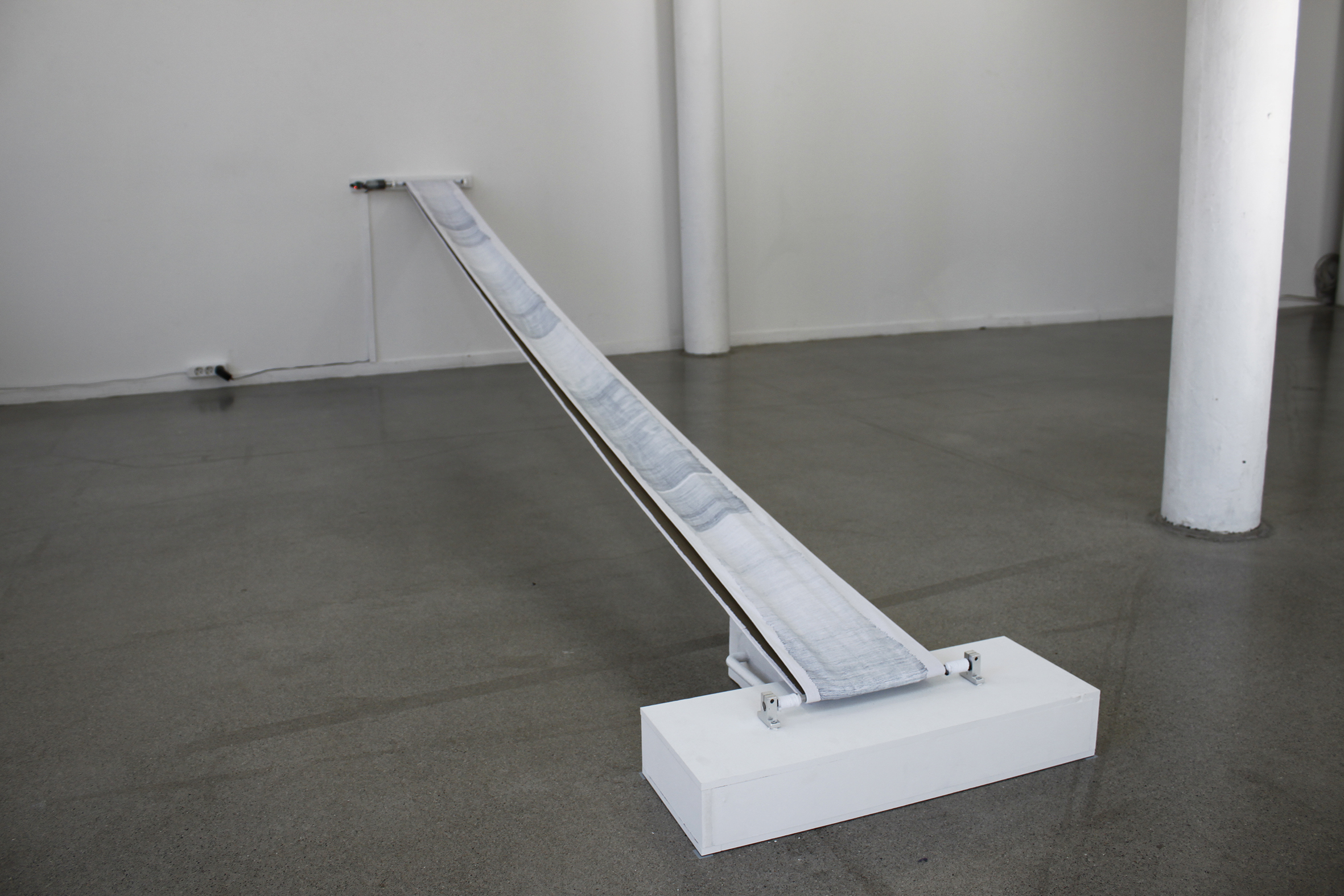Time Practices: 8 Hours
2019
71 x 20.5 x 377 cm
Textile printer ink on cotton, motor and electronic parts
Time table of 8 Hours labor:
00:00:00
Start of first attempt
02:09:26
End of first attempt/start of first break
02:31:17
End of first break/start of second attempt
04:16:48
End of second attempt/start of second break
04:53:06
End of second break/start of third attempt
08:03:38
End of the third attempt/ End of the practice
I draw one line for eight hours with two breaks in-between.
Time Practices: 8 Hours is an eight-meter textile scroll that documents eight-hours of labor. The width is set according to the moving distance of my forearm, which I have the elbow fixed as an axis. The length is derived from a rehearsed outcome combined with the desired time frame. I tested out the average drawing speed and aligned it with the choice of using 8 hours as a time limit. It corresponds to my previous experience working in a 24/7 store, which a day is perfectly divided into three shifts for the convenient service. The scroll is displayed in combination with a slow-speed motor device, creating a loop, and visual association to an industrial conveyor belt.
Through this 'practice', I created a set-up to capture the slices of time: the accidents happened in the ordinary. In this case, the preset dimension of the scroll is the ordinary, and the slices of time are the ink stain from the squeeze of the fountain brush during the session; the gradient greyness from the soon-to-be running-out ink; the shaky and unstable line from tiredness, and more. I termed these minor uncertainties, unforeseen blips, anomalies as contingencies, they are deliberate intentional but also unpredictable. By pushing my body to an extreme, I documented and tracked time that I experienced and perceived at utmost. Through excluding the interfering factors to a single action, everything turns inwards, and the timeline becomes distorted, which of memory and expectation don’t seem linear and intertwined. I was able to consume and sense time in its nature. In previous 'practices', I used my perception of time as the basic unit to build up the new system in an objective timeframe, but in this 'practice', the method is reversed. A fixed and objective time frame is set up first, and the discourse on psychological time followed.
2019
71 x 20.5 x 377 cm
Textile printer ink on cotton, motor and electronic parts
Time table of 8 Hours labor:
00:00:00
Start of first attempt
02:09:26
End of first attempt/start of first break
02:31:17
End of first break/start of second attempt
04:16:48
End of second attempt/start of second break
04:53:06
End of second break/start of third attempt
08:03:38
End of the third attempt/ End of the practice
I draw one line for eight hours with two breaks in-between.
Time Practices: 8 Hours is an eight-meter textile scroll that documents eight-hours of labor. The width is set according to the moving distance of my forearm, which I have the elbow fixed as an axis. The length is derived from a rehearsed outcome combined with the desired time frame. I tested out the average drawing speed and aligned it with the choice of using 8 hours as a time limit. It corresponds to my previous experience working in a 24/7 store, which a day is perfectly divided into three shifts for the convenient service. The scroll is displayed in combination with a slow-speed motor device, creating a loop, and visual association to an industrial conveyor belt.
Through this 'practice', I created a set-up to capture the slices of time: the accidents happened in the ordinary. In this case, the preset dimension of the scroll is the ordinary, and the slices of time are the ink stain from the squeeze of the fountain brush during the session; the gradient greyness from the soon-to-be running-out ink; the shaky and unstable line from tiredness, and more. I termed these minor uncertainties, unforeseen blips, anomalies as contingencies, they are deliberate intentional but also unpredictable. By pushing my body to an extreme, I documented and tracked time that I experienced and perceived at utmost. Through excluding the interfering factors to a single action, everything turns inwards, and the timeline becomes distorted, which of memory and expectation don’t seem linear and intertwined. I was able to consume and sense time in its nature. In previous 'practices', I used my perception of time as the basic unit to build up the new system in an objective timeframe, but in this 'practice', the method is reversed. A fixed and objective time frame is set up first, and the discourse on psychological time followed.


